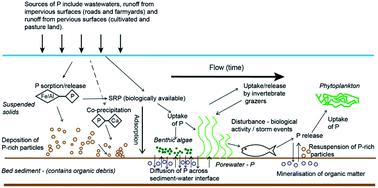当前位置:
X-MOL 学术
›
Environ. Sci.: Processes Impacts
›
论文详情
Our official English website, www.x-mol.net, welcomes your feedback! (Note: you will need to create a separate account there.)
Physico-chemical factors controlling the speciation of phosphorus in English and Welsh rivers.
Environmental Science: Processes & Impacts ( IF 5.5 ) Pub Date : 2020-07-06 , DOI: 10.1039/d0em00093k Rupert Goddard 1 , Michael J Gardner , Thomas H Hutchinson , Paul Lunt , Holly B C Pearson , Alan Tappin , H Kate Schofield , Tarryn Attfield , Paul Worsfold , Sean Comber
Environmental Science: Processes & Impacts ( IF 5.5 ) Pub Date : 2020-07-06 , DOI: 10.1039/d0em00093k Rupert Goddard 1 , Michael J Gardner , Thomas H Hutchinson , Paul Lunt , Holly B C Pearson , Alan Tappin , H Kate Schofield , Tarryn Attfield , Paul Worsfold , Sean Comber
Affiliation

|
Phosphorus is a finite resource essential for global food production. However, excessive loss to river systems from diffuse sources (typically agricultural) and point sources (e.g. waste water treatment works and industrial effluent) can lead to negative environmental impacts, including changes to diatom and invertebrate community structure. Current environmental quality standards for phosphorus in the UK have been based on reactive phosphorus, which is poorly defined and comprises an unknown proportion of soluble reactive phosphorus and chemically extractable particulate phosphorus. This research assesses the influencing factors that may control soluble reactive phosphorus concentrations in rivers, including dissolved iron, as well as partitioning processes associated with the presence of total suspended solids, and questions the reliability of the assumptions used when setting environmental quality standards. The extensive phosphorus speciation monitoring carried out across a wide geographic area of England and Wales shows that not all phosphorus as measured by the molybdenum blue method is either soluble or necessarily bioavailable, particularly at concentrations in the range in which the Environmental Quality Standard for ‘Good’ status (typically less than 100 μg P L−1) has been set. Phosphorus speciation can change due to physico-chemical processes which vary spatially and/or temporally, including precipitation with iron and partitioning with suspended solids.
中文翻译:

控制英国和威尔士河中磷形态的物理化学因素。
磷是全球粮食生产必不可少的有限资源。但是,分散来源(通常是农业来源)和点源(例如 waste water treatment works and industrial effluent) can lead to negative environmental impacts, including changes to diatom and invertebrate community structure. Current environmental quality standards for phosphorus in the UK have been based on reactive phosphorus, which is poorly defined and comprises an unknown proportion of soluble reactive phosphorus and chemically extractable particulate phosphorus. This research assesses the influencing factors that may control soluble reactive phosphorus concentrations in rivers, including dissolved iron, as well as partitioning processes associated with the presence of total suspended solids, and questions the reliability of the assumptions used when setting environmental quality standards. The extensive phosphorus speciation monitoring carried out across a wide geographic area of England and Wales shows that not all phosphorus as measured by the molybdenum blue method is either soluble or necessarily bioavailable, particularly at concentrations in the range in which the Environmental Quality Standard for ‘Good’ status (typically less than 100 μg P L-1)已设置。磷的形态会因在空间和/或时间上发生变化的物理化学过程而发生变化,包括铁沉淀和悬浮固体分配。
更新日期:2020-08-19
中文翻译:

控制英国和威尔士河中磷形态的物理化学因素。
磷是全球粮食生产必不可少的有限资源。但是,分散来源(通常是农业来源)和点源(例如 waste water treatment works and industrial effluent) can lead to negative environmental impacts, including changes to diatom and invertebrate community structure. Current environmental quality standards for phosphorus in the UK have been based on reactive phosphorus, which is poorly defined and comprises an unknown proportion of soluble reactive phosphorus and chemically extractable particulate phosphorus. This research assesses the influencing factors that may control soluble reactive phosphorus concentrations in rivers, including dissolved iron, as well as partitioning processes associated with the presence of total suspended solids, and questions the reliability of the assumptions used when setting environmental quality standards. The extensive phosphorus speciation monitoring carried out across a wide geographic area of England and Wales shows that not all phosphorus as measured by the molybdenum blue method is either soluble or necessarily bioavailable, particularly at concentrations in the range in which the Environmental Quality Standard for ‘Good’ status (typically less than 100 μg P L-1)已设置。磷的形态会因在空间和/或时间上发生变化的物理化学过程而发生变化,包括铁沉淀和悬浮固体分配。


























 京公网安备 11010802027423号
京公网安备 11010802027423号